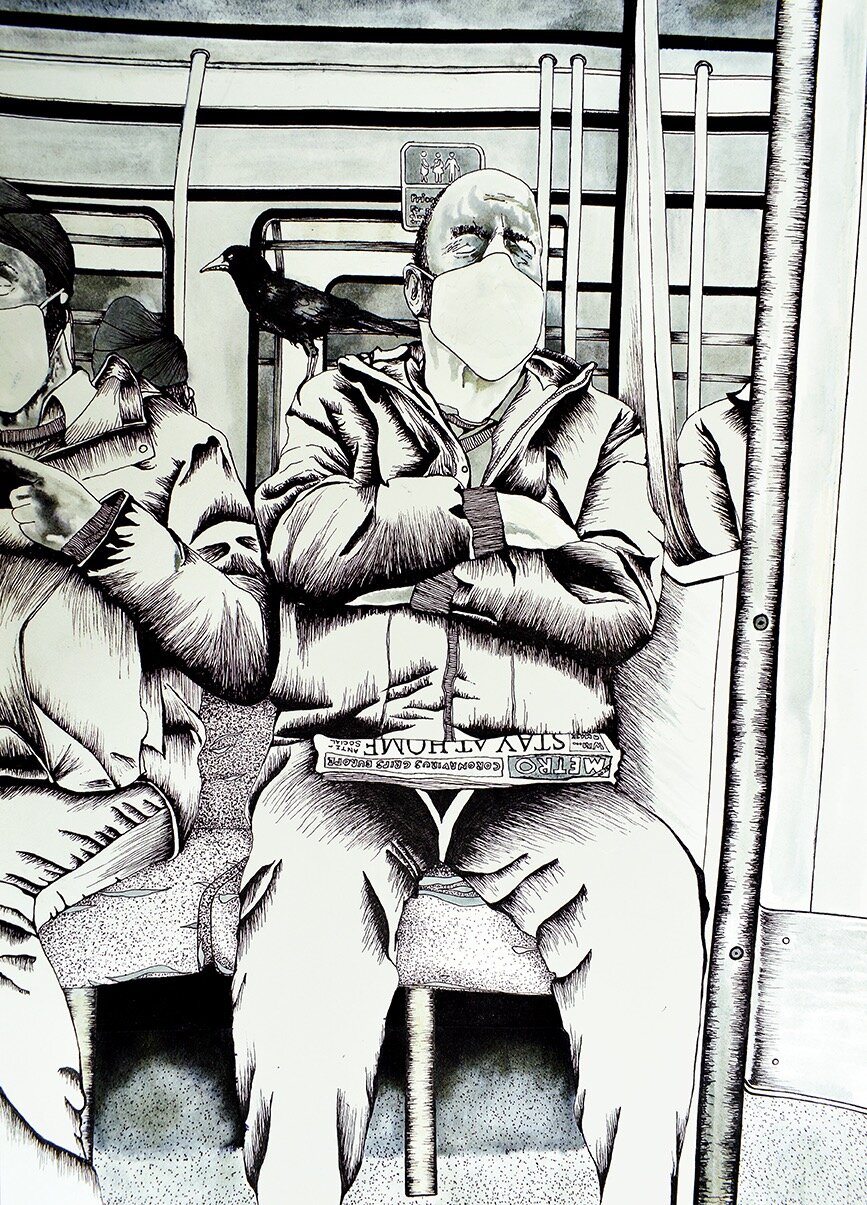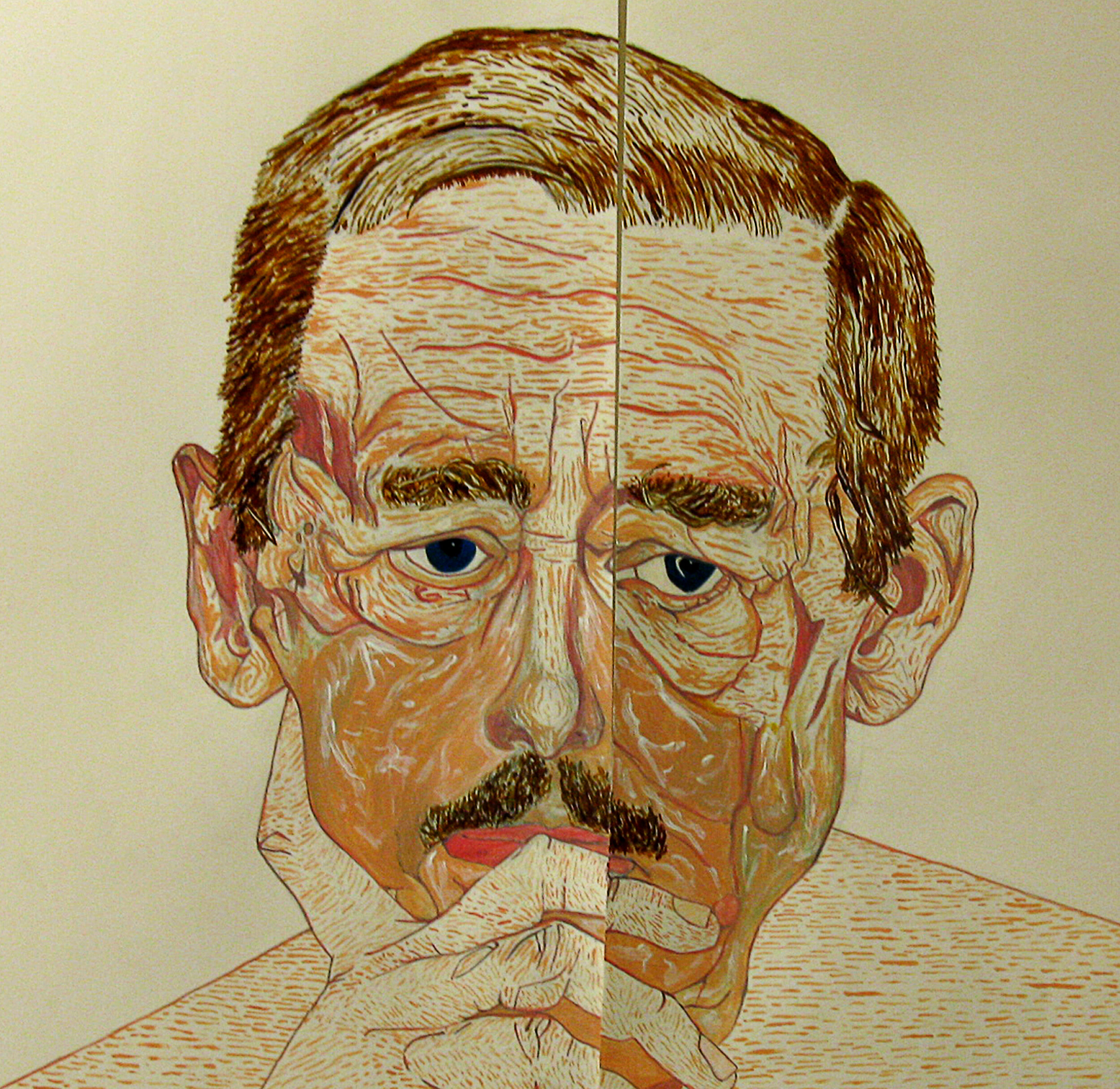New artwork!
'All too Human', 29.7 x 42.0cm, pen and ink on 230g akvarel paper, 2020
I would like to know what this says to you. Let me know what you think by leaving a comment below.

‘When doves cry’, black ink and pen on 230g akvarel paper, 29.7 x 42.0 cm, 2021
New artwork!
'All too Human', 29.7 x 42.0cm, pen and ink on 230g akvarel paper, 2020
I would like to know what this says to you. Let me know what you think by leaving a comment below.

5 years ago I made this piece of rats wearing masks, patiently waiting for something to happen. It was a protest piece on how cosmetic companies wrongfully test their products on animals, so I subverted the role-play of humans with rats. Looking back at it now during this pandemic, it reads differently to me. When I look at it now, the rats are now us, anxious, with masks on, not social distancing, but waiting for something positive to happen. It seems like this piece is more relevant now. Tell me what you think about it and how it makes you feel.


Francis Bacon, ‘Three Studies for Figures at the Base of a Crucifixion’, 1944

The Garrick Arms - Stay Strong

Francis Bacon, ‘Three Studies for Figures at the Base of a Crucifixion’, 1944

Patrick Heron
‘Yellow Painting : October 1958 May/June 1959’

"The truth is that everyone is bored, and devotes himself to cultivating habits. Our citizens work hard, but solely with the object of getting rich. Their chief interest is commerce, and their chief aim in life is, as they call it, 'doing business.'"


‘Survival of the Fittest’,
29.7 x 42.0cm, watercolour on 230g akvarel paper,
2020

The opening for the ‘It’s not just black and white’ exhibition went really well. I always feel as if I could have interacted more, but I just did not want to come across as if I was approaching people as if it was some aggressive sales pitch. The exhibition was situated in an old derelict building, with a charm of decay and neglection, it was a perfect space to show artwork that made a change from displaying art in white, minimal spaces.
Read More
You’ve been invited to the exhibition ‘It’s Not Just Black and White’ taking place at The Water House Railway Institute on Friday the 17th January 6.pm-9.pm
The show investigates themes of being biracial and multi-ethnic in a society that is fixed by categorisation. Our unique experiences of tethering between ethnic groups means we are often generalised to the one ethnicity we visually appear to belong to. Our stories are lost and underrepresented. Here’s a chance to build our own culture where we celebrate our uniqueness and break down stereotypes of racial identification.
We want you to be a part of this amazing event which showcases six talented biracial artists!
Ali Tareen, Rohini Jones, Jessica Butcher, Latifah A. Stranack, Louise Evans & Jessica Mallard
The exhibition is curated by Natasha Clarke
We can’t wait to see you there.
The Water House Railway Institute,
2 Queen St, York,
YO24 1AD, UK

When I made this portrait of the ex-president of the Czech Republic, Vaclav Havel back in early Spring 2015, the world seemed to be in a better place (even though tensions were slowly increasing). Overall, democratic leadership in western countries had a better position than in 2019: Barack Obama (the first black president of the USA) was still in power, the vote for Brexit hadn't happened yet, The Czech Republic had no oligarch as prime minister. On the other hand, Right-wing populism, and fake news was on the rise, but nobody really expected nationalism to be in such a strong position as it does in today’s world.
Businesses and businessmen now dominated the political arena more than ever, controlling and turning countries into businesses and citizens into its employees.
I painted Vaclav Havel in a classical thinking position. He sits and stares vacantly, sad into the distance, thinking about what went wrong with democracy in today’s world. He fought his whole life for it in Czechoslovakia and was punished and imprisoned for seeking fairness. The fall of the iron curtain was a beautiful moment for freedom and human rights, and Havel was rightly so the first president of Czechoslovakia after Communism.
Looking back now, we can see how divided these countries have become and this piece for me is a mirror of not just how Havel would feel about the current state of western politics, but also how I and most people I know feel about the current state of politics. I composed Havel onto two pieces of paper, which symbolises him as a man of peace and equality, but a torn man, divided and separated from having inner and outer peace.
Today is the anniversary Vaclav Havel passed away back in 2012.
Let's remember him by not forgetting about democracy, but embracing human rights, promoting freedom of speech and exposing fake news. Not forgetting to wear short trousers :)


As you may know, drawing is my number one passion, I love drawing and get an enormous amount of peace and comfort when I’m alone drawing. I also love travelling and exploring new places and trying different food. For a long time, I’ve wanted to combine the two together.
Read More
At the beginning of my recent workshop, a student used the ‘classic sentence’: ‘I can’t draw!’. My immediate reaction was a combination of genuine confusion and bewilderment. Even though, I have heard the same words throughout the years, it is something I have always had trouble understanding.
When I hear the words: ‘ I can’t draw’, I interpret the words to be ‘I can’t breathe’. I simply find this not to be true; if someone wouldn’t be able to breathe, they simply would cease to exist. As while as someone can breathe, someone can also communicate. Either, verbally or visually. Drawing has evolved and also how we view our world. It’s just that our own creativity has been suppressed and we are afraid to making mistakes and being judged and mocked.
The true fundamentals of drawing is a matter of using perceptive intuition and expression. It is a matter of making use more of your left brain and switching to your right brain. It is a matter of making mistakes.
When we were children, we were playful, we explored and we learnt to have fun and we weren’t afraid of making mistakes. Institutions such as: Schools, family and work project a limited and rigid view on how to see the world and how to approach it, often frowning upon creativity and focusing more on logic. This is the mistake. This why you think you can’t draw. This is why your confidence in creativity has been eroded.
In order to improve on drawing, we have to think about how we see perspectives differently. I think it is important to practice using the eye as a muscle to exercise, as we would with our feet when we go jogging. It is not so much about technical skill, but more to do with how we perceive things when we look at things and how to execute it in a way that suggests an honesty.
If the sentences of ‘I can’t draw’ lingers long enough in your head, then despite what you do, the idea becomes manifested as true. Another sentence is followed with: ‘but I want to draw it how I see it’.
Most often than not, most people aspire for the presentation preference of the geometric, pragmatic, two-dimensional, structural engineering process. The concept for perceptive intuition becomes void and anything with wonky eyes and a long nose gets shunned upon by the person’s own creation or feels embarrassed if presented to others.
Avoid being an expert. Old ideas become a repetitive ritual. New methods can become a gateway for an improved you.
Stop labeling objects! Question, challenge and dissect the thing you want to draw. This can include drawing from multiple viewpoints, using different materials and having distance from it (hang it up - step back and look for what needs improvement)
Cezanne used to sit; analyzing and studying his subject for long periods before actually working on his pieces.
Instead of trying to draw a perfect symmetric face or to replicate the subject, think about what you are actually seeing in front of you as opposed to what comes from memory and what you think it should look like. Consider using your pencil as a measuring instrument. Pick the subject up if it’s small or walk around it - see it from a different angle. Get close to the subject. The more you research and try to understand the subject, the easier it will be to translate it from your eyes and hands to the paper or canvas.
Feel confident in what you know and understand the best you can about the subject. That will make you better, if not great at drawing.
A fun and enjoyable time being back in the studio in Letna, Prague. With 8 new students from America and Canada on an art break retreat. Even though we could all speak in the same language and understand one another, what I pleasantly encountered was the sheer diversity and dynamic creativity that came through in their visual language and what resulted in their final outcomes. Collectively, it worked well; the group shared ideas and I encouraged them to give feedback in every session. In terms of individualistically, it was evident that there were moments of fun and enjoyment, hence the wonderful work that came out of the workshops. I feel that a true sense of fun and enjoyment, whilst being creative is strongly missing in all realms throughout our current society and I believe we should all embrace it a bit more.
Thank you to everyone who participated and a big thank you to Richard, Doug and Klara!
Stay creative! 😉
Mind the gap artwork
Read More